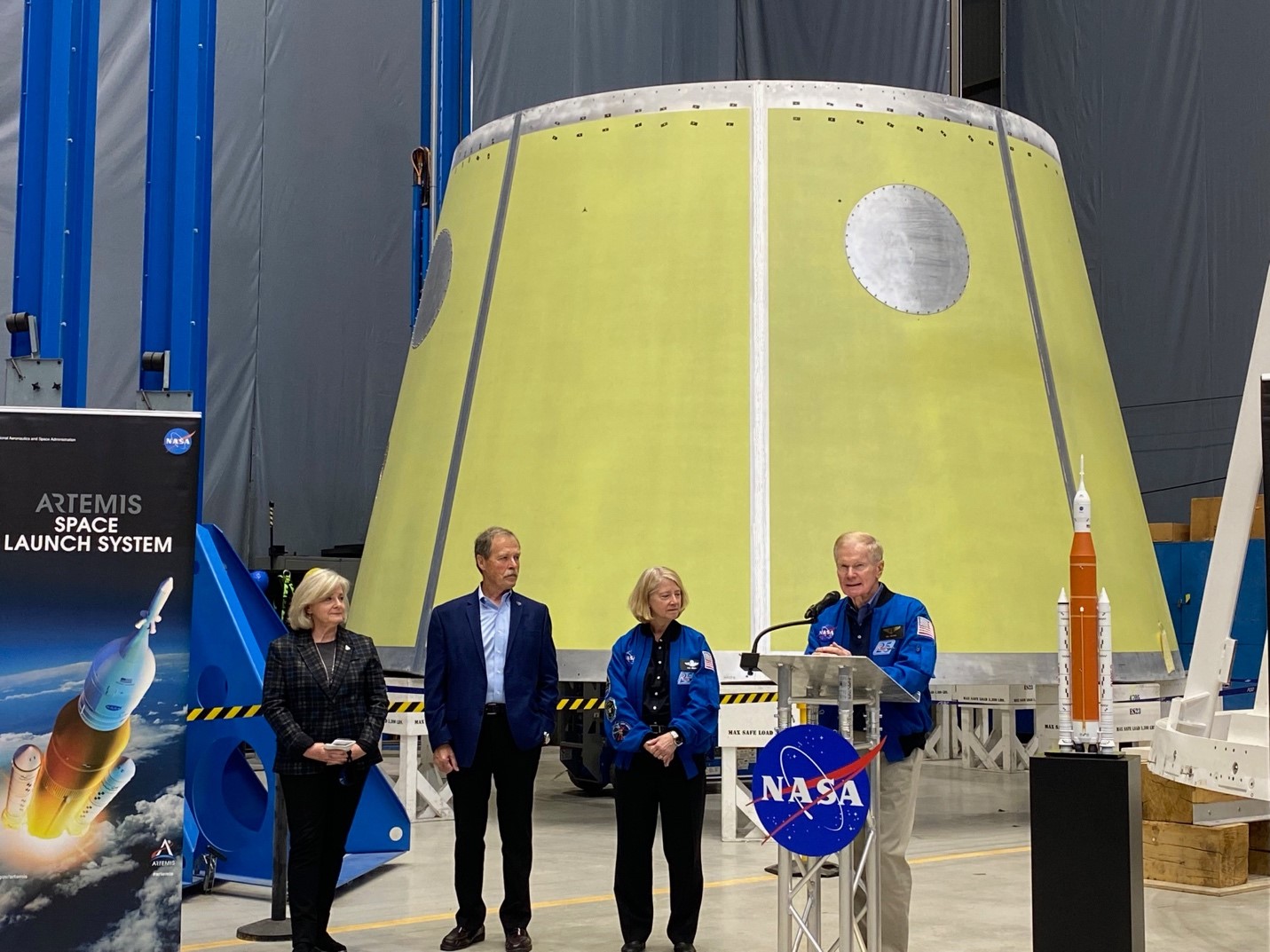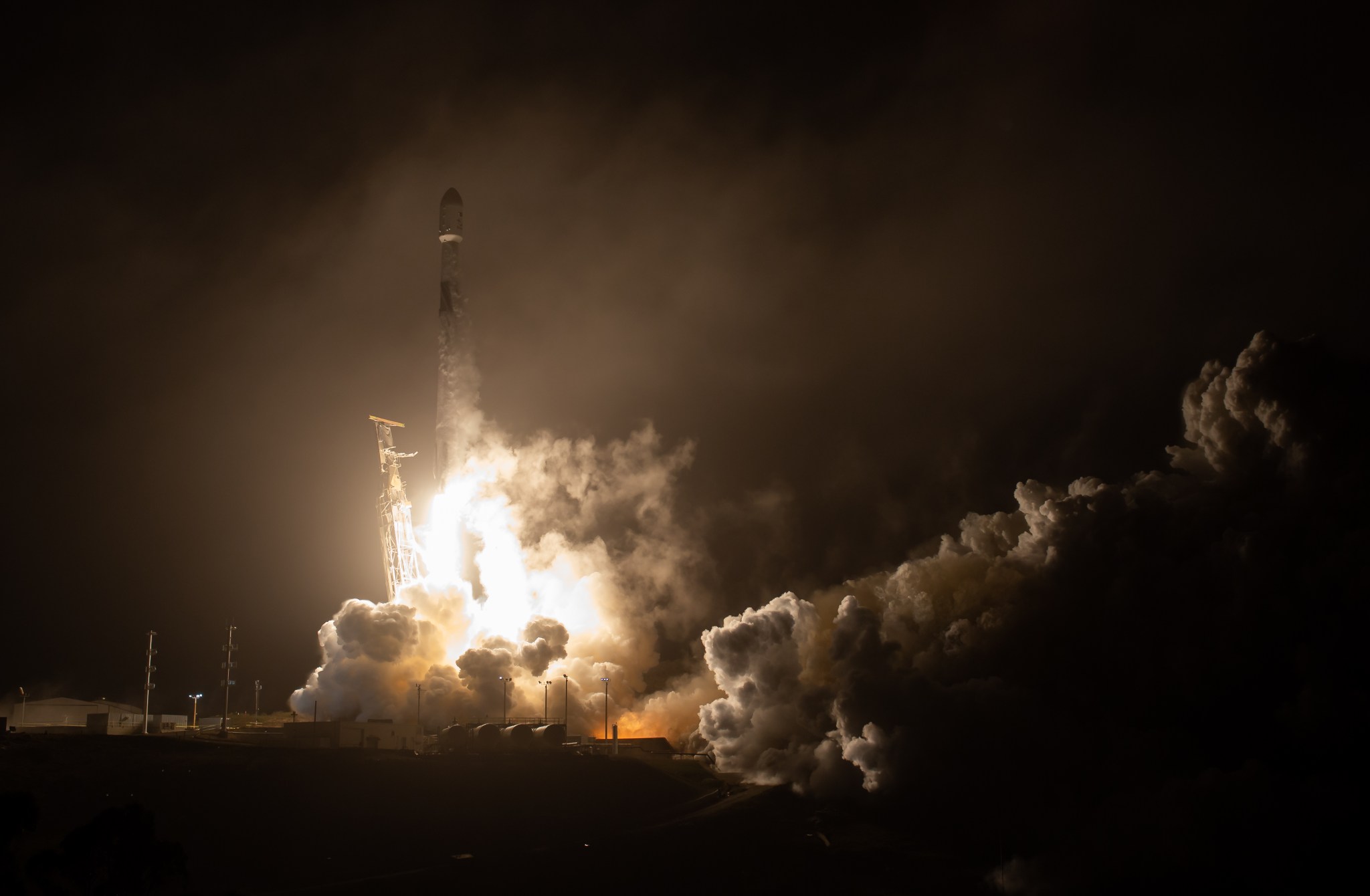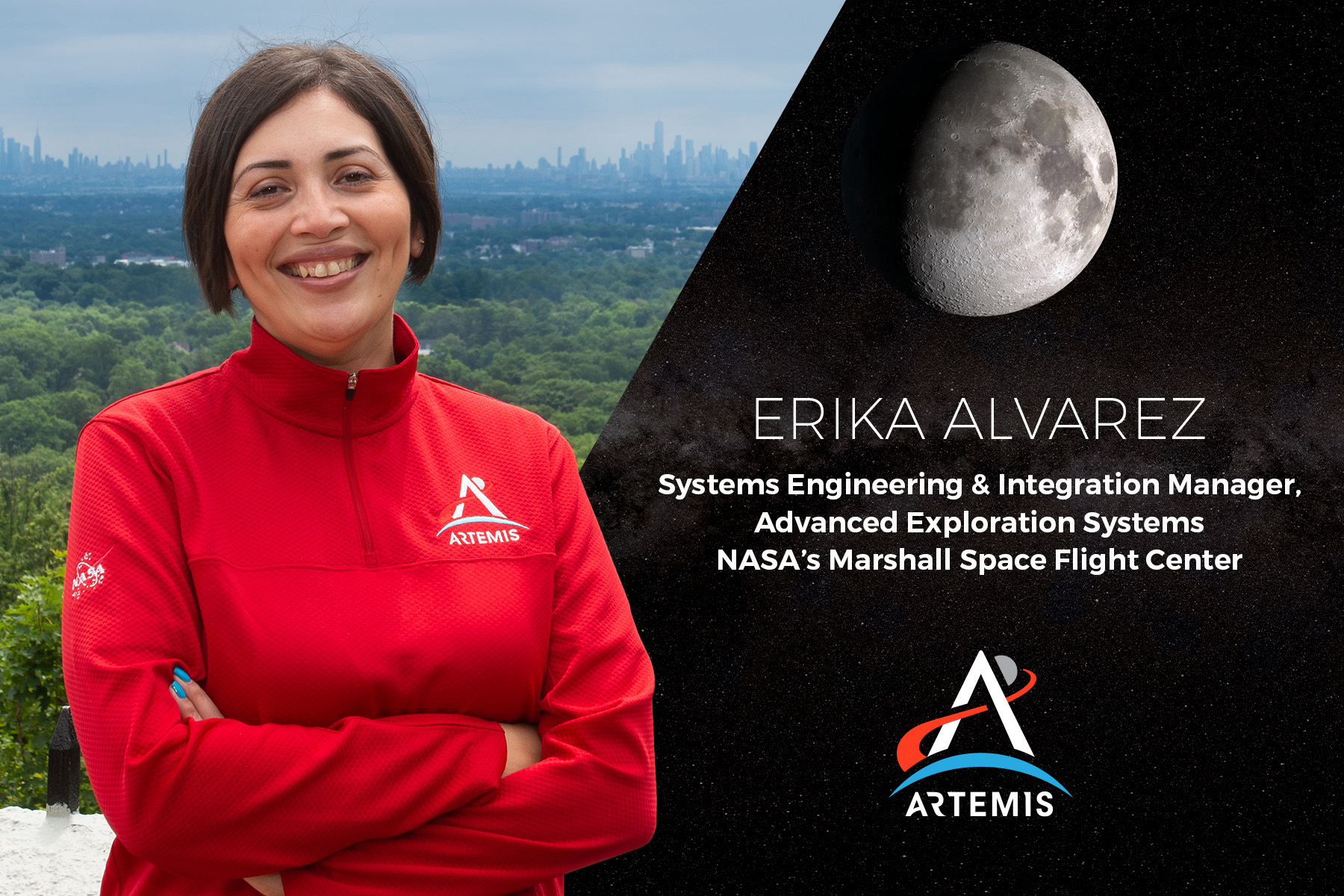NASA Leadership Visits Marshall to Discuss Artemis, Future Exploration
By Wayne Smith
NASA Administrator Sen. Bill Nelson and Deputy Administrator Pam Melroy visited the agency’s Marshall Space Flight Center on Nov. 29 and 30 for tours and briefings on Marshall’s role in the Artemis program and other capabilities that enrich many facets of the nation’s space exploration endeavors.
It was their first visit to Marshall in their current roles.

Nelson and Melroy visited Marshall’s Surface and Transit Habitats Environmental Control and Life Support Systems, and Advanced Manufacturing for large space structures facilities. Marshall’s capabilities in advanced manufacturing, in-space transportation, habitats, and life support systems have enabled the nation’s human exploration systems for decades.
“Is it any wonder that NASA has been voted the best place to work in the federal government for the last nine years straight? You can see it in the gleam in the eye, beyond the mask, of all of these people who have talked to us today,” said Nelson, who was sworn in as NASA’s 14th administrator in May and tasked with carrying out the Biden administration’s vision for the agency. “You have a very special part in our nation’s history and in our nation’s space program.
“It’s not the Apollo generation. It’s the Artemis Generation, and you have seen a lot of that generation here today in this briefing. It’s going to be extraordinary, what we’re doing, and we’re just talking about a small part of NASA.”
Marshall has a vital role in planned Artemis missions and manages NASA’s deep space rocket, the Space Launch System (SLS), which will power the next generation of exploration. NASA’s Orion spacecraft is secured atop the powerful SLS rocket at the agency’s Kennedy Space Center, and the integrated system is entering the final phase of preparations for an upcoming uncrewed flight test around the Moon. The mission will pave the way for a future flight test with crew before NASA establishes a regular cadence of more complex missions with astronauts on and around the Moon under Artemis.
Nelson and Melroy also highlighted the benefits that both NASA and Marshall would receive under President Joe Biden’s Build Back Better Act, including major infrastructure improvements, modernizing critical Marshall resources currently supporting priority programs and projects across the agency, including the agency’s Artemis, the International Space Station, commercial crew, and technology development and science efforts.

Melroy said she visited Marshall many times when she was an astronaut working on hardware for the space station. She said Marshall is “an amazing place.”
“I think one of the things that’s really exciting is just to realize that it takes so much effort to build a brand new rocket, especially one that is going to be the most powerful rocket ever designed,” Melroy said. “It’s important to recognize the key difference between what we did with Apollo, which was very primitive technology by comparison, was to prove that we could go to the moon and come back.
“This time around, we’re going to stay. Marshall is playing a crucial role in that.”
Marshall Director Jody Singer said Nelson and Melroy were impressed with the work and expertise at the center.
“Marshall has a proud legacy in space exploration, and we will build on that with future missions,” Singer said. “We’re thrilled that NASA leadership had the opportunity to see ongoing work and developments at Marshall supporting programs across the agency.”
Smith, a Media Fusion employee, supports Marshall’s Office of Strategic Analysis & Communications.
NASA, SpaceX Launch DART: First Test Mission to Defend Planet Earth
NASA’s Double Asteroid Redirection Test (DART), the world’s first full-scale mission to test technology for defending Earth against potential asteroid or comet hazards, launched Nov. 24 at 12:21 a.m. CST on a SpaceX Falcon 9 rocket from Space Launch Complex 4 East at Vandenberg Space Force Base in California.
Just one part of NASA’s larger planetary defense strategy, DART – built and managed by the Johns Hopkins Applied Physics Laboratory in Laurel, Maryland – will impact a known asteroid that is not a threat to Earth. Its goal is to slightly change the asteroid’s motion in a way that can be accurately measured using ground-based telescopes.
DART will show that a spacecraft can autonomously navigate to a target asteroid and intentionally collide with it – a method of deflection called kinetic impact. The test will provide important data to help better prepare for an asteroid that might pose an impact hazard to Earth, should one ever be discovered. LICIACube, a CubeSat riding with DART and provided by the Italian Space Agency, will be released prior to DART’s impact to capture images of the impact and the resulting cloud of ejected matter. Roughly four years after DART’s impact, the European Space Agency’s Hera project will conduct detailed surveys of both asteroids, with particular focus on the crater left by DART’s collision and a precise determination of asteroid Dimorphos’ mass.
“DART is turning science fiction into science fact and is a testament to NASA’s proactivity and innovation for the benefit of all,” NASA Administrator Sen. Bill Nelson said. “In addition to all the ways NASA studies our universe and our home planet, we’re also working to protect that home, and this test will help prove out one viable way to protect our planet from a hazardous asteroid should one ever be discovered that is headed toward Earth.”
At 1:17 a.m., DART separated from the second stage of the rocket. Minutes later, mission operators received the first spacecraft telemetry data and started the process of orienting the spacecraft to a safe position for deploying its solar arrays. About two hours later, the spacecraft completed the successful unfurling of its two, 28-foot-long, roll-out solar arrays. They will power both the spacecraft and NASA’s Evolutionary Xenon Thruster – Commercial ion engine, one of several technologies being tested on DART for future application on space missions.
“At its core, DART is a mission of preparedness, and it is also a mission of unity,” said Thomas Zurbuchen, associate administrator for the Science Mission Directorate at NASA Headquarters. “This international collaboration involves DART, ASI’s LICIACube, and ESA’s Hera investigations and science teams, which will follow up on this groundbreaking space mission.”
DART’s one-way trip is to the Didymos asteroid system, which comprises a pair of asteroids. DART’s target is the moonlet, Dimorphos, which is approximately 530 feet in diameter. The moonlet orbits Didymos, which is approximately 2,560 feet in diameter.
Since Dimorphos orbits Didymos at much a slower relative speed than the pair orbits the Sun, the result of DART’s kinetic impact within the binary system can be measured much more easily than a change in the orbit of a single asteroid around the Sun.
“We have not yet found any significant asteroid impact threat to Earth, but we continue to search for that sizable population we know is still to be found,” said Lindley Johnson, planetary defense officer at NASA Headquarters. “Our goal is to find any possible impact, years to decades in advance, so it can be deflected with a capability like DART that is possible with the technology we currently have. DART is one aspect of NASA’s work to prepare Earth should we ever be faced with an asteroid hazard. In tandem with this test, we are preparing the Near-Earth Object Surveyor Mission, an space-based infrared telescope scheduled for launch later this decade and designed to expedite our ability to discover and characterize the potentially hazardous asteroids and comets that come within 30 million miles of Earth’s orbit.”
The spacecraft will intercept the Didymos system between Sept. 26 and Oct. 1, 2022, intentionally slamming into Dimorphos at roughly 4 miles per second. Scientists estimate the kinetic impact will shorten Dimorphos’ orbit around Didymos by several minutes. Researchers will precisely measure that change using telescopes on Earth. Their results will validate and improve scientific computer models critical to predicting the effectiveness of the kinetic impact as a reliable method for asteroid deflection.
“It is an indescribable feeling to see something you’ve been involved with since the ‘words on paper’ stage become real and launched into space,” said Andy Cheng, one of the DART investigation leads at the Johns Hopkins Applied Physics Laboratory and the individual who came up with the idea of DART. “This is just the end of the first act, and the DART investigation and engineering teams have much work to do over the next year preparing for the main event ─ DART’s kinetic impact on Dimorphos. But tonight, we celebrate!”
The Johns Hopkins Applied Physics Laboratory manages the DART mission for NASA’s Planetary Defense Coordination Office as a project of the agency’s Planetary Missions Program Office at Marshall Space Flight Center. NASA provides support for the mission from several centers, including the Jet Propulsion Laboratory, Goddard Space Flight Center, Johnson Space Center, Glenn Research Center, and Langley Research Center.
Read the complete feature here. The launch was also featured on “This Week @ NASA,” a weekly video program broadcast on NASA-TV and posted online.
NASA’s New X-ray Mission Will Unlock the Secrets of Extreme Cosmic Objects
By Molly Porter and Rick Smith
NASA is gearing up to launch a new set of X-ray eyes on the cosmos. The first space observatory of its kind, the Imaging X-ray Polarimetry Explorer, or IXPE, is built to study some of the most energetic objects in the universe – the remnants of exploded stars, powerful particle jets spewing from feeding black holes, and much more.
IXPE won’t be as big and strong as the Chandra X-ray Observatory, NASA’s flagship X-ray telescope. But what IXPE lacks in imaging power, it makes up by seeing an aspect of cosmic X-ray sources that has gone largely unexplored until now – polarization.
“The launch of IXPE marks a bold and unique step forward for X-ray astronomy,” said Dr. Martin Weisskopf, IXPE’s principal investigator and chief scientist for X-ray astronomy at NASA’s Marshall Space Flight Center. “IXPE will tell us more about the precise nature of cosmic X-ray sources than we can learn by studying their brightness and color spectrum alone.”
X-rays are a form of high-energy light. They originate from places where matter is under extreme conditions – violent collisions, enormous explosions, 10-million-degree temperatures, and strong magnetic fields. They carry detailed information about the powerful phenomena that produce them. But Earth’s atmosphere blocks cosmic X-rays from reaching the ground, so they can only be collected by telescopes in space.
Polarized light carries unique details about where the light comes from and what it passes through. Light is made up of interconnected waves of electric and magnetic fields that interact with each other in a way that makes them oscillate, or vibrate, at right angles to the path the light is traveling. The vibrations can be up-and-down, side-to-side, or anywhere between. Polarized light is made up of electric fields that vibrate in just one, uniform direction.
Light from a typical bulb, for example, produces electric fields that vibrate every which way. If the light is scattered or reflected by particles or surfaces, the light can become polarized – with vibrations aligned in just one direction.
By analyzing polarized X-rays with IXPE, scientists can learn more about the structure and behavior of celestial objects, their surrounding environments, and the physics of how X-rays come to be.
IXPE’s polarization measurements will also hold clues to questions astronomers have wondered about for decades, such as:
- What is the spin of a black hole?
- What powers the mysterious brightness of pulsars – spinning dead stars so dense that a spoonful would weigh as much as a mountain on Earth?
- Does our understanding of the fundamental laws of physics hold up throughout the whole universe?
“IXPE will help us test and refine our theories of how the universe works,” Weisskopf said. “There may be even more exciting answers ahead than the ones we’ve hypothesized. Better yet, we may find whole lists of new questions to ask!”
For Weisskopf, who is also the project scientist for Chandra, adding polarization to the X-ray mix has long been a goal. Making such measurements is difficult. It requires sensitive instruments, a rocket ride into space, and long observing times.
IXPE’s powerful new X-ray vision is made possible by state-of-the-art polarization detectors developed in Italy. IXPE carries three identical telescopes. Each has a set of nested, cylinder-shaped mirrors that collect X-rays and feed them to a detector, which takes a picture of incoming X-rays and measures both the amount and direction of polarization.
“This is going to be groundbreaking in terms of X-ray data acquisition,” Weisskopf said. “We’ll be analyzing the results for decades to come.”
IXPE is set to launch Dec. 9 on a Falcon 9 rocket from NASA’s Kennedy Space Center. IXPE is a partnership between NASA and the Italian Space Agency. Ball Aerospace of Boulder, Colorado, is the main industry partner.
Porter is a public affairs officer in Marshall’s Office of Strategic Analysis & Communications. Smith, a Manufacturing Technical Solutions employee, supports the Office of Strategic Analysis & Communications.
LCRD Ready for Launch
The Laser Communications Relay Demonstration (LCRD) is scheduled to launch Dec. 5 from Cape Canaveral Space Force Station in Florida with a two-hour launch window that opens at 3:04 a.m. CST. LCRD will fly as a hosted payload aboard a Department of Defense spacecraft as part of the Space Test Program (STP-3) mission. LCRD will continue NASA’s exploration of laser communications to support future missions to the Moon and beyond. This video provides a brief overview of LCRD. Learn more about NASA’s journey to the LCRD launch on Inside Marshall. (NASA)
I am Artemis: Erika Alvarez
Growing up in the busy, urban city of West New York, New Jersey, Erika Alvarez learned about the universe through books. When she looked up to the sky, she would only see the Moon at night and maybe one star.
As she got older, Alvarez was bitten by the space bug. She grew up knowing she wanted to be in the aerospace field and work at NASA, as it would challenge her and fuel her passion for learning.
“It wasn’t until I moved to Alabama that I noticed you could see the Moon during the day,” Alvarez said. After the move, she realized there was so much more of the universe to see from Earth. The experience opened her eyes and mind to the endless possibilities of space and the opportunities available at NASA.
“Being a first generation Latino American, we were raised to dream big,” Alvarez said. “Growing up, I knew that I wanted to do something that was challenging. I knew that I wanted to do something where I learned [something new] every day.”
Since joining NASA in 2004, Alvarez has worked on multiple programs, including the Space Shuttle, Space Launch System, Human Landing System, and other rocket work. Her involvement in these programs has allowed her to bridge the gaps between diverse teams that must work together to find solutions to meet mission goals.
Alvarez is now a Systems Engineering & Integration manager for Advanced Exploration Systems at NASA’s Marshall Space Flight Center. As an integral part of the Artemis team, she is responsible for leading Systems Engineering and Integration across the Gateway, Human Landing System, Lunar Terrain Vehicle programs, and integration with Exploration Systems Development division programs. In other words, she leads cross-program integration, mission design and development, and system engineering functions across Artemis to prepare for the first human landing in over 50 years.
Alvarez holds a bachelor’s degree in aerospace engineering from Penn State. She enjoys sharing her experiences with young people entering the science, technology, engineering, and math fields.
“I have found that I have never reached a limit,” she said. “The more that I learn and the more baby steps that I take, I gain the confidence to keep pushing myself.”





























